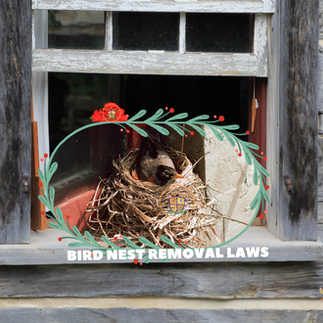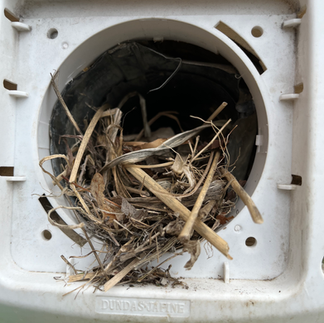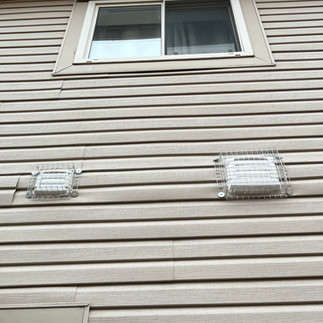
Roof Soffit Secrets
Do Raccoons Eat Birds? As a homeowner, you probably haven't given this a second though. However, those birds you see land on you roof gable end and disappear inside the tinniest soffit gap should give you cause for concern and wonder this very question.
Domestic cats, alongside raccoons, are significant predators of birds in residential areas. One such concern is the predation of baby birds by raccoons. Understanding this dynamic is crucial for preventing raccoons from gaining access to your attic and causing significant damage.
This article explores how a birds nest with bird eggs and baby chicks attract raccoons, the impact on your home, and effective strategies to protect your feathered friends and your property.
Pro Wildlife Control Tip: 👆Look up - Looking up at your roof from a distance and for close is a good habit to get into. White stains on the shingles or straw-like nesting material poking out of the soffit are indications of a bird nest
Do Raccoons Eat Birds
Yes, raccoons do eat birds. Raccoons are known as opportunistic predators with a varied diet that includes birds, bird eggs, and small mammals. Wild raccoons are opportunistic predators with diverse dietary habits, including birds, bird eggs, and small mammals. In addition to catching birds, raccoons will also raid nests, eating both eggs and unsuspecting birds. Their adaptability allows them to thrive in various environments, making them a common sight in urban areas and residential neighbourhoods. With their sharp claws and ability to climb trees, raccoons can easily gain access to bird nests, whether in the wild or near your home. While they naturally hunt for food, raccoons can become problematic when they target bird nests within your home’s structure, leading to potential damage and loss of birds. In rural areas, raccoons expand their diet to include chickens, mice, and frogs. They’ll even catch fish from koi ponds. Their natural hunting instincts and ability to kill other animals make them effective predators, always on the lookout for their next food meal.
Bird Nests in Roof Soffits: An Attractive Duo
Birds often choose roof soffits as ideal nesting sites due to their sheltered and elevated locations. These bird nests provide safe havens for young birds and are easily accessible for feeding and protection. However, these nests inadvertently become a magnet for raccoons and other predators seeking easy food sources. Various predators, including raccoons, also target flying birds. Small birds and their eggs offer a more tempting meal than raiding trash cans for raccoons, leading them to raid nests and potentially damage your roof soffits in the process.
The Chain Reaction: From Birds to Raccoons or Squirrels
When raccoons target bird nests in your roof soffits, they may break open these structures to access the eggs and young birds. The destructive behaviour by the raccoon species not only threatens the bird population but also provides them with a convenient entry point into your attic. Once inside, raccoons can establish a residence, leading to further issues such as noise disturbances, structural damage, and potential health hazards from droppings and urine.
Why Newly Built Subdivisions Are Vulnerable
In newly built subdivisions, the absence of large trees means fewer natural predators for smaller birds like starlings, songbirds, sparrows, and robins and similar other birds. As a result, birds are among the first pests to exploit new structures for nesting. Without proper management, these bird nests can attract raccoons and other wildlife, creating a domino effect that leads to larger predator infestations. Early intervention is essential to prevent raccoons from following birds into your home’s structure.
Attracting Factors: Beyond Bird Nests
Raccoons are attracted to various food sources around residential areas, including bird feeders, pet food left outdoors, and open garbage cans. Domestic and feral cats, as well as stray cats, can also contribute to attracting raccoons by disrupting the bird population and creating additional food sources. Additionally, raccoons are agile hunters capable of climbing trees and other structures to reach and attack birds nests, making them persistent threats.
Bird-Friendly Tips to Discourage Raccoons
Raccoons can be a significant threat to bird populations, especially when they raid bird feeders, eat bird eggs, and attack young birds. To discourage raccoons from visiting your yard and protect your feathered friends, follow these bird-friendly tips:
Secure Bird Feeders: Opt for raccoon-proof bird feeders or cover your existing feeders with a physical barrier, such as a plastic or metal mesh. This prevents raccoons from accessing the seed meant for wild birds.
Remove Food Sources: Keep your yard free of food debris, including pet food, garbage, and compost. Store trash cans in a secure location and use animal-proof lids to prevent raccoons from scavenging.
Protect Bird Nests: Install a raccoon guard or a physical barrier around bird nests to prevent raids. Nesting boxes with secure roofs and entrance holes can also protect young birds from these clever predators.
Use Deterrents: Spray or sprinkle a raccoon deterrent, such as a commercial repellent or a homemade mixture of hot peppers and garlic, around the perimeter of your yard. This can discourage raccoons from venturing into your space.
Install a Motion-Activated Sprinkler: A motion-activated sprinkler can startle raccoons and other wildlife, keeping them away from your bird feeders and nests. This humane method is effective in deterring unwanted visitors.
Keep Your Yard Clean: Regularly clean up fallen fruit, berries, and other food sources that may attract raccoons. A tidy yard is less appealing to these opportunistic feeders.
Use Raccoon-Proof Birdhouses: Install birdhouses with secure roofs and entrance holes to prevent raccoons from getting inside and eating bird eggs or young birds. This simple step can make a big difference in protecting your feathered friends.
Avoid Feeding Wild Raccoons: Refrain from feeding wild raccoons, as this can make them dependent on humans and increase their presence in your yard. Encouraging natural foraging behaviors is better for both raccoons and your bird populations.
Install a Fence: Consider installing a fence around your yard to prevent raccoons from entering. The fence should be at least 6 feet tall and extend at least 12 inches below ground to prevent burrowing.
Monitor Your Yard: Regularly monitor your yard for signs of raccoon activity, such as tracks, scat, or damage to bird feeders or nests. Prompt action can deter raccoons and protect your bird populations.
By following these bird-friendly tips, you can discourage raccoons from visiting your yard and protect your feathered friends from these clever and opportunistic predators. Taking these steps not only safeguards your home but also supports the health and safety of local bird populations.

Preventing Raccoon Infestations
To protect your home from raccoons and preserve your bird populations, consider the following preventative measures:
Secure Roof Soffits and Attic Openings
Ensure that all roof soffits and attic openings are properly sealed to prevent raccoons from gaining access. Regularly inspect these areas for signs of damage or tampering and reinforce them as needed.
Manage Bird Feeding Practices
While bird feeders attract wild birds, they can also draw raccoons. Place bird feeders away from your home and use squirrel-proof designs to minimize raccoon access. Clean up spilled bird seed regularly to reduce attractants.
Control Pet Food and Garbage
Store pet food in secure containers and avoid leaving it outdoors. Use garbage cans with tight-fitting lids to prevent raccoons from scavenging for food. Removing these additional food sources can make your property less appealing to raccoons.
Monitor and Protect Bird Nests
If you notice bird nests forming in vulnerable areas, consult a wildlife removal professional to safely relocate them. Protecting bird nests from raccoons helps maintain healthy populations of our winged friends and reduces the risk of raccoon infestations.
Regular Home Inspections
Conduct routine inspections of your home’s exterior, including trees, bushes, and other potential entry points. Early detection of raccoon activity allows for prompt intervention and prevents larger infestations.

When to Call Wildlife Control Professionals
Despite your best efforts, raccoons may still find ways into your home. Recognizing the signs of a raccoon infestation is crucial for timely action. Look for noises in the attic, visible damage to roof soffits, or the presence of raccoon droppings. If you suspect a raccoon has taken up residence, contact a reputable, humane wildlife company immediately. Professional services can safely and effectively remove raccoons, repair damage, and implement measures to prevent future invasions.
The Impact on Bird Populations and Local Wildlife
Raccoons not only threaten your home but also disrupt local ecosystems by preying on wild birds and other small animals, even large birds are at risk to fall prey. Reducing raccoon access to your property helps protect our feathered friends and maintains the balance of local wildlife. By taking proactive steps, humans contribute to the preservation of avian creatures and the overall health of our community’s environment.
Conclusion
Understanding the relationship between raccoons and baby birds is essential for homeowners aiming to protect their properties and support local wildlife. Raccoons are adept predators, raiding nests looking for food within roof soffits, leading to attic infestations and significant home damage. By implementing preventative measures, managing food sources, and seeking professional wildlife removal company when necessary, you can safeguard your home from these dangerous predators. Take action today to ensure a harmonious coexistence with almost anything in nature, while maintaining the integrity and safety of your residence.








